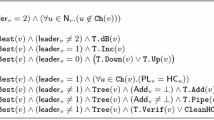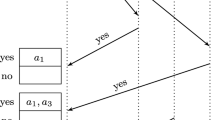Abstract
Herman’s algorithm is a synchronous randomized protocol for achieving self-stabilization in a token ring consisting of N processes. The interaction of tokens makes the dynamics of the protocol very difficult to analyze. In this paper we study the expected time to stabilization in terms of the initial configuration.
It is straightforward that the algorithm achieves stabilization almost surely from any initial configuration, and it is known that the worst-case expected time to stabilization (with respect to the initial configuration) is Θ(N 2). Our first contribution is to give an upper bound of 0.64N 2 on the expected stabilization time, improving on previous upper bounds and reducing the gap with the best existing lower bound. We also introduce an asynchronous version of the protocol, showing a similar O(N 2) convergence bound in this case.
Assuming that errors arise from the corruption of some number k of bits, where k is fixed independently of the size of the ring, we show that the expected time to stabilization is O(N). This reveals a hitherto unknown and highly desirable property of Herman’s algorithm: it recovers quickly from bounded errors. We also show that if the initial configuration arises by resetting each bit independently and uniformly at random, then stabilization is significantly faster than in the worst case.
Research supported by EPSRC (EP/G069158/1). Stefan Kiefer is supported by a postdoctoral fellowship of the German Academic Exchange Service (DAAD).
Access this chapter
Tax calculation will be finalised at checkout
Purchases are for personal use only
Preview
Unable to display preview. Download preview PDF.
Similar content being viewed by others
References
Balding, D.: Diffusion-reaction in one dimension. J. Appl. Prob. 25, 733–743 (1988)
PRISM case studies. Randomised self-stabilising algorithms, http://www.prismmodelchecker.org/casestudies/self-stabilisation.php
Cox, D., Miller, H.: The theory of stochastic processes. Chapman & Hall/CRC (2001)
Dijkstra, E.W.: Self-stabilizing systems in spite of distributed control. Commun. ACM 17(11), 643–644 (1974)
Dolev, S.: Self-Stabilization. MIT Press, Cambridge (2000)
Durrett, R., Kesten, H.: Random Walks, Brownian Motion and Interacting Particle Systems. Birkhauser Verlag AG, Basel (1991)
Feller, W.: An introduction to probability theory and its applications, vol. 1. John Wiley & Sons, Chichester (1968)
Flatebo, M., Datta, A.K.: Two-state self-stabilizing algorithms for token rings. IEEE Trans. Softw. Eng. 20(6), 500–504 (1994)
Fribourg, L., Messika, S., Picaronny, C.: Coupling and self-stabilization. Distributed Computing 18, 221–232 (2005)
Habib, S., Lindenberg, K., Lythe, G., Molina-Paris, C.: Diffusion-limited reaction in one dimension: Paired and unpaired nucleation. Journal of Chemical Physics 115, 73–89 (2001)
Herman, T.: Probabilistic self-stabilization. Information Processing Letters 35(2), 63–67 (1990), Technical Report at ftp://ftp.math.uiowa.edu/pub/selfstab/H90.html
Israeli, A., Jalfon, M.: Token management schemes and random walks yield self-stabilizing mutual exclusion. In: Proceedings of PODC 1990, pp. 119–131. ACM, New York (1990)
Kiefer, S., Murawski, A., Ouaknine, J., Worrell, J., Zhang, L.: On stabilization in Herman’s algorithm. Technical report, arxiv.org (2011), http://arxiv.org/abs/1104.3100
Kutten, S., Patt-Shamir, B.: Stabilizing time-adaptive protocols. Theor. Comput. Sci. 220(1), 93–111 (1999)
Liggett, T.M.: Interacting particle systems. Springer, Heidelberg (2005)
McIver, A., Morgan, C.: An elementary proof that Herman’s ring is θ(n 2). Inf. Process. Lett. 94(2), 79–84 (2005)
Nakata, T.: On the expected time for Herman’s probabilistic self-stabilizing algorithm. Theoretical Computer Science 349(3), 475–483 (2005)
Schneider, M.: Self-stabilization. ACM Comput. Surv. 25(1), 45–67 (1993)
Author information
Authors and Affiliations
Editor information
Editors and Affiliations
Rights and permissions
Copyright information
© 2011 Springer-Verlag Berlin Heidelberg
About this paper
Cite this paper
Kiefer, S., Murawski, A.S., Ouaknine, J., Worrell, J., Zhang, L. (2011). On Stabilization in Herman’s Algorithm. In: Aceto, L., Henzinger, M., Sgall, J. (eds) Automata, Languages and Programming. ICALP 2011. Lecture Notes in Computer Science, vol 6756. Springer, Berlin, Heidelberg. https://doi.org/10.1007/978-3-642-22012-8_37
Download citation
DOI: https://doi.org/10.1007/978-3-642-22012-8_37
Publisher Name: Springer, Berlin, Heidelberg
Print ISBN: 978-3-642-22011-1
Online ISBN: 978-3-642-22012-8
eBook Packages: Computer ScienceComputer Science (R0)




